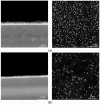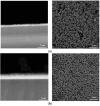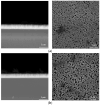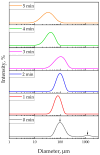The Application of Ultrasound Pre-Treatment in Low-Temperature Synthesis of Zinc Oxide Nanorods
- PMID: 39459685
- PMCID: PMC11509445
- DOI: 10.3390/ma17204980
The Application of Ultrasound Pre-Treatment in Low-Temperature Synthesis of Zinc Oxide Nanorods
Abstract
Zinc oxide, due to its unique physicochemical properties, including dual piezoelectric and semiconductive ones, demonstrates a high application potential in various fields, with a particular focus on nanotechnology. Among ZnO nanoforms, nanorods are gaining particular interest. Due to their ability to efficiently transport charge carriers and photoelectric properties, they demonstrate significant potential in energy storage and conversion, as well as photovoltaics. They can be prepared via various methods; however, most of them require large energy inputs, long reaction times, or high-cost equipment. Hence, new methods of ZnO nanorod fabrication are currently being sought out. In this paper, an ultrasound-supported synthesis of ZnO nanorods with zinc acetate as a zinc precursor has been described. The fabrication of nanorods included the treatment of the precursor solution with ultrasounds, wherein various sonication times were employed to verify the impact of the sonication process on the effectiveness of ZnO nanorod synthesis and the sizes of the obtained nanostructures. The morphology of the obtained ZnO nanorods was imaged via a scanning electron microscope (SEM) analysis, while the particle size distribution within the precursor suspensions was determined by means of dynamic light scattering (DLS). Additionally, the dynamic viscosity of precursor suspensions was also verified. It was demonstrated that ultrasounds positively affect ZnO nanorod synthesis, yielding longer nanostructures through even reactant distribution. Longer nanorods were obtained as a result of short sonication (1-3 min), wherein prolonged treatment with ultrasounds (4-5 min) resulted in obtaining shorter nanorods. Importantly, the application of ultrasounds increased particle homogeneity within the precursor suspension by disintegrating particle agglomerates. Moreover, it was demonstrated that ultrasonic treatment reduces the dynamic viscosity of precursor suspension, facilitating faster particle diffusion and promoting a more uniform growth of longer ZnO nanorods. Hence, it can be concluded that ultrasounds constitute a promising solution in obtaining homogeneous ZnO nanorods, which is in line with the principles of green chemistry.
Keywords: ALD technique; nanorod crystallization; particle agglomerate disintegration; ultrasound treatment; zinc oxide nanorods.
Conflict of interest statement
The authors declare no conflicts of interest.
Figures












References
-
- Sher E.K., Alebić M., Marković Boras M., Boškailo E., Karahmet Farhat E., Karahmet A., Pavlović B., Sher F., Lekić L. Nanotechnology in medicine revolutionizing drug delivery for cancer and viral infection treatments. Int. J. Pharm. 2024;660:124345. doi: 10.1016/j.ijpharm.2024.124345. - DOI - PubMed
-
- del Rosario Herrera-Rivera M., Torres-Arellanes S.P., Cortés-Martínez C.I., Navarro-Ibarra D.C., Hernández-Sánchez L., Solis-Pomar F., Pérez-Tijerina E., Román-Doval R. Nanotechnology in food packaging materials: Role and application of nanoparticles. RSC Adv. 2024;14:21832–21858. doi: 10.1039/D4RA03711A. - DOI - PMC - PubMed
-
- Gupta R.K., Abd El Gawad F., Ali E.A., Karunanithi S., Yugiani P., Srivastav P.P. Nanotechnology: Current Applications and Future Scope in Food Packaging Systems. Meas. Food. 2024;13:100131. doi: 10.1016/j.meafoo.2023.100131. - DOI
-
- Kazemi Shariat Panahi H., Hosseinzadeh-Bandbafha H., Dehhaghi M., Orooji Y., Mahian O., Shahbeik H., Kiehbadroudinezhad M., Kalam M.A., Karimi-Maleh H., Salehi Jouzani G., et al. Nanotechnology Applications in Biodiesel Processing and Production: A Comprehensive Review. Renew. Sustain. Energy Rev. 2024;192:114219. doi: 10.1016/j.rser.2023.114219. - DOI
Grants and funding
LinkOut - more resources
Full Text Sources

